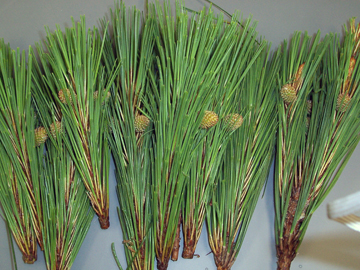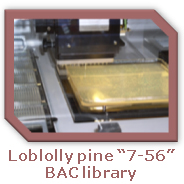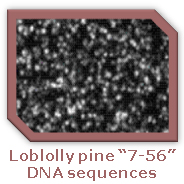
Young shoots from the P. taeda genotype "7-56"
LOBLOLLY PINE GENOMICS
MGEL is currently involved in two major projects centered on study of the loblolly pine genome. Specifically:
| (1) Accelerating Pine Genomics (NSF DBI-0421717) - Click on project title to go to the project website or click on the icons below to view information on the Pinus taeda "7-56" BAC library or the DNA sequence data generated through NSF DBI-0421717. | ||||
 |
 | |||
| (2) Sequencing Loblolly Pine BACs (DOE-JGI) - Click on project title for details | ||||
About Loblolly Pine
Loblolly pine (LP; Pinus taeda L.) is an organism of tremendous economic and ecological importance and a key representative of the conifers, an ancient lineage of plants that dominate many of the worlds temperate and boreal ecosystems (Earle 2005). LPs fast growth, amenability to intensive silviculture, and high-quality lumber/pulp have made it the cornerstone of the U.S. forest products industry and the most economically important crop of any kind in the southeastern states. LP is the most commonly planted tree species in America approximately 75% of all seedlings planted each year are LPs (McKeand et al. 2003). Pines and other trees are arguably America's greatest natural resource benefiting humans and wildlife in countless ways. The yearly value of wood, paper, and other tree products equals or exceeds that of every other U.S. crop while the ornamental, aesthetic, recreational, and ecological value of trees is immeasurable. Moreover, LP's ability to efficiently convert CO2 into biomass and its widespread use as a plantation tree have also made it a cost-effective feedstock for lignocellulosic ethanol production (Frederick et al. 2008) and a promising tool in efforts to curb greenhouse gas levels via carbon sequestration (Gough & Seiler 2004).
Bioenergy
Pines and other conifers are currently the focus of extensive biomass research (for review, see Mead 2005 and Rubilar et al. 2005) and are recognized by the Department of Energy (DOE) as an important feedstock in current and future green energy production (Perlack et al. 2005). While growing pine trees simply as lignocellulosic feedstocks would be a questionable enterprise, those parts of trees left after lumber and pulp have been extracted (e.g., needles, small branches, bark, wood chips, sawdust, and pulping liquors) would seem an ideal feedstock. Not only are such residues abundant, but they have traditionally been used as a fuel (via combustion) to generate electricity/steam the forest products industry co-generates over half of its electrical requirements in this manner (DOE-EIA 2003). With relatively modest adaptations, tree waste could be utilized in lignocellulosic ethanol production. Using pine and other forest tree waste rather than human or animal foods (most notably corn) as feedstocks helps keep food prices low and hopefully helps curb conversion of productive forestlands into resource-intensive agricultural lands. Pine residues can be used to generate ethanol via thermo-chemical conversion and standard sugar fermentation (Barbosa et al. 1992; Ewanick et al. 2007; Frederick et al. 2008).
Global warming
Carbon sequestration by photosynthetic organisms is a promising means of curbing global warming (Malhi et al. 2002; Jackson & Schlesinger 2004), and consequently the DOE has taken steps to identify and develop carbon sequestration species (see Litynski et al. 2006 for review). Of note, forest and tree plantations are highly promising terrestrial carbon sinks as CO2 fixation on forest/plantation lands is ten times more efficient than carbon sequestration in agricultural soils (Jackson & Schlesinger 2004). This finding is supported by a continuing continent-wide study of carbon dioxide exchange that reveals forests to be the principal biological carbon sinks in North America (Peters et al. 2007). Fast-growing southern pines, most notably LP, appear to be among the most proficient plant species in sequestering carbon (DeLucia et al. 1999; Huang et al. 2004). In theory, conifers should be among the best biological tools in fighting the greenhouse effect as they are long-lived plants that convert a relatively large part of excess carbon stores into wood. Additionally, most conifers do not shed the bulk of their needles/leaves at the end of each growing season, and thus they do not turnover carbon at the rate of deciduous trees. However, LaDeau and Clark (2001) demonstrated that while standard plantation LPs grown in an environment enriched in CO2 showed a marked increase in growth, the majority of sequestered carbon was allocated to relatively transient reproductive structures (cones and seeds). Moreover, the trees reached sexual maturity faster and were smaller at maturity. Clearly, effective biological carbon sequestration will not simply be a matter of growing more trees, but rather growing trees that are more effective at converting carbon into wood.
Why is it important to understand the pine genome?
The demand for wood/fibers from southern yellow pines is projected to increase 35-40% within the next 50 years to accommodate the needs of a growing populace and to offset decreased tree harvesting in western and northern states. However, the number of acres reserved for tree growth is likely to decline. Consequently, the U.S. forest products industry is looking for ways to significantly increase wood yields per acre, a pursuit greatly limited by a paucity of information on pine genes. Despite the importance of LP and other conifers, genomic sequence information for this taxon is extremely limited. While EST resources for LP are relatively advanced, efficient tree improvement will ultimately require integration of EST, sequence polymorphism, gene expression, and genetic data with actual genomic DNA sequence including non-coding regulatory regions missed by EST approaches. Isolation, sequencing, and characterization of the genes of loblolly pine represents a means to (1) better understand the evolutionary success of pine, (2) develop environmentally sound strategies for dealing with pine diseases and pests, (3) effectively manipulate genes responsible for pines many economic traits, and (4) maximize yield per acre, a goal that is important to lumber and paper industries as well as those interested in LP's potential as a bioenergy and carbon sequestration species.
REFERENCES
> Barbosa MF, Beck MJ, Fein JE, Potts D, Ingram LO (1992)
Efficient fermentation of Pinus sp. acid hydrolysates by an ethanologenic strain
of Escherichia coli. Appl. Environ. Microbiol. 58: 1382-1384.
> DeLucia EH, Hamilton JG, Naidu SL et al. (1999) Net
primary production of a forest ecosystem with experimental CO2 enrichment.
Science 284: 1177-1179.
> DOE-EIA (4/28/2003)
The Forest Products Industry. U.S. Dept. of Energy, Energy Info. Admin.
> Earle J (2005) The Gymnosperm Database.
www.conifers.org
> Ewanick SM, Bura R, Saddler JN (2007) Acid-catalyzed
steam pretreatment of lodgepole pine and subsequent enzymatic hydrolysis and
fermentation to ethanol. Biotechnol. Bioeng. 98: 737-746.
> Frederick WJ, Jr., Lien SJ, Courchene CE, Demartini
NA, Ragauskas AJ, Iisa K (2008) Production of ethanol from carbohydrates from
loblolly pine: A technical and economic assessment. Bioresour. Technol.,
doi:10.1016/j.biortech.2007.08.086.
> Gough CM, Seiler JR (2004) Belowground carbon dynamics
in loblolly pine (Pinus taeda) immediately following diammonium phosphate
fertilization. Tree Physiol 24: 845-851.
> Huang C-H, Bates R, Kronrad GD, Cheng S (2004) Economic
analyses of sequestering carbon in loblolly pine, cherrybark oak, and northern
red oak in the United States. Environ. Manage. 32 Suppl.: S187-S199.
> Jackson RB, Schlesinger WH (2004) Curbing the U.S. carbon
deficit. Proc. Natl. Acad. Sci. USA 101: 15827-15829.
> LaDeau SL, Clark JS (2001) Rising CO2 levels
and the fecundity of forest trees. Science 292: 95-98.
> Litynski JT, Klara SM, McIlvried HG, Srivastava RD
(2006) The United States Department of Energy's Regional Carbon Sequestration
Partnerships program: A collaborative approach to carbon management. Environ.
Int. 32: 128-144.
> Malhi Y, Meir P, Brown S (2002) Forests, carbon and global
climate. Philos. Transact. A Math. Phys. Eng Sci. 360: 1567-1591.
> McKeand S, Mullin T, Byram T, White T (2003) Deployment
of genetically improved loblolly and slash pines in the South. J. Forest.
101: 32-37.
> Mead DJ (2005) Opportunities for improving plantation productivity.
How much? How quickly? How realistic? Biomass & Bioenergy 28:
249-266.
> Perlack RD, Wright LL, Turhollow AF, Graham RL, Stokes
BJ, Erbach DC (2005)
Biomass as a Feedstock for a Bioenergy and Bioproducts Industry: The Technical
Feasibility of a Billion-Ton Annual Supply. U.S. Department of Energy/U.S.
Department of Agriculture.
> Peters W, Jacobson AR, Sweeney C et al. (2007) An atmospheric
perspective on North American carbon dioxide exchange: CarbonTracker. Proc.
Natl. Acad. Sci. USA 104: 18925-18930.
> Rubilar RA, Allen HL, Kelting DL (2005) Comparison of
biomass and nutrient content equations for successive rotations of loblolly
pine plantations on an Upper Coastal Plain Site. Biomass & Bioenergy
28: 548-564.





